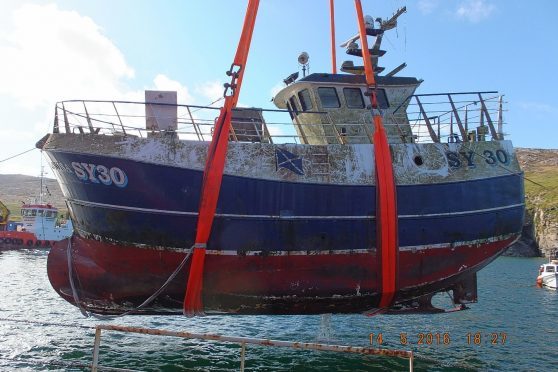The wreck of the boat at the centre of the worst fishing disaster off the Outer Hebrides in half a century has been raised from where it sunk last month.
Three men were lost and a fourth only survived after swimming to shore when the MV Louisa went down last month.
Young father and sole survivor Lachlann Armstrong told how he and his fellow crewmen were left with the nightmare scenario of staying with a reportedly faulty liferaft or swimming for shore.
But now, the Marine Accidents Investigation Branch (MAIB) has confirmed that the Louisa had been lifted from the sea bed in a bid to help find out what caused the crabber to sink off Mingulay on April 9.
The boat is being taken by barge, towed by a tug, to Glasgow to be examined by experts.
“The vessel has been raised and is en route to Glasgow,” said a spokesman for the MAIB. “A number of our inspectors are overseeing the operation.”
Once in port, it will mean investigators will finally get to probe any possible mechanical issues surrounding the tragedy.
Investigators want to know how water came to fill the 15-metre boat as it lay at anchor in calm seas and if all the automatic alarms that sound when there is a leak activated.
They also particularly want to know why the boat’s liferaft failed to release and then did not inflate.
Ultimately that failure was instrumental in the three men dying.
The boat had lain comparatively shallow at 33 feet down, with its mast visible at low water.
The MAIB spokesman added:”The aim of our investigation is to establish why the fishing vessel Louisa sank and why lives were lost. A full and detailed report will be published at the end of our investigation.
“If we identify any safety issues during the investigation that require immediate action, the Chief Inspector of Marine Accidents will issue a safety bulletin or make recommendations as appropriate.”
The bodies of Chris Morrison, 27, from Harris, and Martin Johnstone, 29, from Halkirk, Caithness, were found following the tragedy.
Skipper Paul Alliston, 42, a non-swimmer from Lewis, remains missing despite a massive search.
Only Mr Armstrong, 27, from Stornoway survived after swimming ashore.
The crew of the Louisa were asleep while the vessel lay at anchor in a calm sea.
They woke up shocked to find the boat sinking in the early hours of Saturday 9 April.
Quickly throwing on whatever clothes they could find, the four leapt out of their bunks and scrambled up on deck to find cold seawater coming onboard fast.
Speaking soon after the incident, survivor Lachlan Armstrong said the 16-metre-long crab boat was bow down at a steep angle, sliding below the surface, her stern pointing up into the freezing, black night.
Mr Armstrong said they struggled to release the vessel’s only liferaft. Then it failed to inflate leaving the crew to cut open its hard cover protective case and manually unfold the interior rubber material into some kind of floating sheet as best they could.
Recalling the accident at the time, Mr Armstrong explained: “We were all in the sea and it was just the lifejackets we had on holding us up.”
“You were so cold you couldn’t even hold onto it.
“I have no idea how I found the strength to keep going.”
Mr Armstrong had said: “The water was so cold and we were all immersed in the water.
“The raft never inflated – that’s the reason why we weren’t out of the water.
“Being that cold you know the only way you can survive is to get out of the water.”
